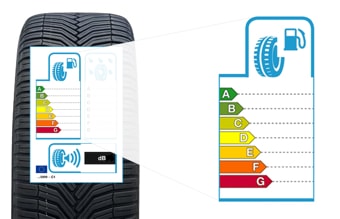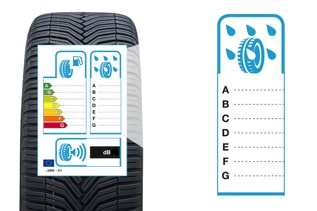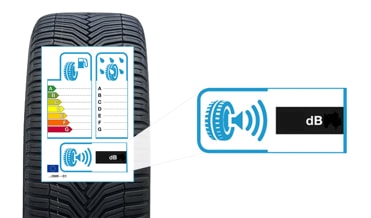Great Deals This April. Save £20 on Selected Brands or Get Gift Cards Worth £50. See all offers
Tyre Labelling
How does tyre labelling work?
The EU Tyre labelling legislation, EC 1222.2009, was introduced on 1 November 2012. The purpose of the legislation is to ensure that every car, van or truck tyre carries a label displaying its performance in three key areas Fuel Efficiency, Wet Grip Rating and Noise Emission Rating.
Tyre labelling makes it possible to compare each tyre across these three key areas, whether you are buying an economy, midrange or premium tyre. The label, which is similar to those on white goods such as fridges and washing machines, is the same for all tyres. This makes it easy to make an accurate comparison between a Bridgestone and an economy tyre, or a midrange and a Michelin tyre.
Additionally, tyre labels offer greater transparency on how each tyre measures up to the competition within each tyre classification and aids an informed decision on which tyre to purchase.
How can tyre labelling help you when choosing new tyres?
When tyre labelling was introduced etyres, alongside the industry in general, welcomed this much needed-piece of legislation. It hands the power of information to you, the customer. Many of the most important figures within the tyre industry called its launch the biggest change to hit the tyre market in over 50 years and they were not wrong.
Previously, many motorists based their choice about which tyre to buy on just price and brand. As your tyres are the only thing connecting you and your vehicle to the road you need to be sure you are getting the best tyres to suit your driving style and vehicle. Tyre labelling gives customers the information they need to make much more informed decisions.
Understanding tyre labels
To find out more about each section of the tyre label click on the links below:
If you require additional information or help selecting your tyre, our National Sales Team are on hand seven days a week to provide impartial guidance and advice on 0808 164 9151.
Tyre labelling FAQ's
Tyre labelling legislation has been active since 1st November 2012. All tyres manufactured after 1st July 2012 carry a label.
Why do we need tyre labelling?Labels enable customers to make more informed choices when they buy their tyres.
Tyres make an important contribution to road safety and to the environmental impact of road transport. Since all tyres are not the same and offer vastly varying performances, the aim behind the EU regulation is to improve both of these key issues.
Which tyres are included in the legislation?The legislation applies to the supply of new car, 4×4, van and truck tyres with rim sizes greater than 254mm and less than 635mm.
Which tyres are excluded from the legislation?The principal exclusions are motorcycle tyres, retread tyres, T-tyre temporary use spare tyres, tyres for pre-1990 vehicles and racing tyres.
Fuel efficiency ratings
One of the key elements shown on the tyre label is a fuel efficiency rating based on the performance the tyre will achieve in this area. Fuel efficiency ratings are explained below.

What is fuel efficiency?
Choosing a tyre which is more fuel efficient can help you to reduce your driving costs and CO2 emissions.
A rolling tyre deforms and loses energy. This energy is known as rolling resistance and this is what directly impacts on your fuel consumption and the environment.
On the label, fuel efficiency ratings are measured according to the rolling resistance of the tyres in ratings of A to G, with A being the most fuel efficient and meaning you use the least fuel for your journey and G being the least fuel efficient. Category D is not used as a grade, which helps to draw a clear line between the top and bottom three grades.
By choosing an A rated tyre over a G rated tyre you could reduce your fuel consumption by up to 7.5%. To put this in real terms, choosing A rated tyres instead of G rated tyres could save you more than 6 litres of fuel every 625 miles.
At an average petrol price of £1.15 per litre, that adds up to a saving of around £250 over the life of the tyres. This is based on an average consumption of 8 litres/65 miles, a fuel price of £1.15/litre and an average tyre mileage of 22,000 miles.
How is rolling resistance calculated?
Rolling resistance is measured by mounting the passenger car tyre on a two metre drum and running it with a defined load and pressure.
To rotate the drum without a tyre, a certain torque needs to be applied. The moment the tyre comes into contact with the drum, the torque required to rotate the drum needs to be increased.
By measuring the difference between the torque of the drum without the tyre and the increase when the tyre comes into contact with the drum it is possible to obtain a rolling resistance coefficient (measured in kg/t). This result is used to define the specific grading on the label.
If you would like assistance choosing the right tyre for you call us on 0808 164 9151.
Wet grip ratings
One of the most important elements shown on each tyre's label is the wet grip rating, something for which all new tyres are tested. Wet grip ratings are explained below.

What is wet grip?
Wet braking performance is a critical safety feature and relates to how quickly you will be able to stop in wet conditions.
Tyres play a crucial role in a vehicle's stopping distance and those with excellent wet grip have shorter braking distances on slippery roads, which is essential for keeping you safe in the rain.
The difference between each grade means an increase or decrease in stopping distance between one or two car lengths (3-6 metres) when braking at 50mph.
The difference between categories A and F is more than 18 metres (testing according to regulation EC1222.2009) in stopping distance. An A-rated tyre provides the shortest braking distances on wet roads, and thus the best grip, whereas an F rated tyre will have the longest braking distance in the wet, ie the worst level of grip.
Categories D and G are not used.
It is important to remember that a tyre with a good rating for wet grip can be trusted for better braking in dry conditions, too. A good rating for wet grip therefore brings with it important safety benefits whatever the conditions. etyres recommends placing utmost importance on a tyre's wet grip rating.
How is it calculated?
According to the tyre labelling legislation wet grip can be tested in one of two ways. The first is the wet braking vehicle test, which measures wet braking performance on a wet road surface, braking from 50mph to 12mph.
The second test is a skid trailer test, which measures friction between the road and a tyre, conducted at 40mph. The end result of both tests provides a Wet Grip Index (WGI), which describes the improvement in percentage in relation to the reference tyre.
To find out more about tyre labelling and for help choosing the right tyres for you, call us on 0808 164 9151.
Noise emission ratings
One of the key elements shown on a tyre's label is a noise emission rating based on the performance a tyre will achieve in this area. Noise emission ratings are explained below.

What are noise emissions?
Noise emissions are the amount of noise made by a tyre when it rolls along the road surface and are recorded as part of the tyre label.
The tyre’s exterior noise is expressed in decibels (dB) and is depicted by a series of black waves.
Three black waves indicate that the tyre produces the most amount of noise on the scale, while one black wave symbolises the quietest.
In fact, three waves is the current limit, while two meets future laws and one is a further 3dBs below the statutory requirement.
1 wave - low noise tyre
2 waves - average noise tyre
3 waves - noisier tyre
How is it calculated?
The tyre label noise emission rating is based on an ISO pass-by noise test, whereby noise is measured as a car travelling at 50mph passes by two microphones that are positioned 7.5m from the centre line at a height of 1.2mh.
Why are noise emission ratings important?
The noise a tyre makes might not seem a crucial buying factor, but for motorists spending a large amount of time driving on motorways it may be an important factor which contributes to driving comfort. It's also relevant if you drive a convertible car with the roof down. Until the launch of tyre labelling it was not possible to know the noise level of a tyre until it had been fitted and driven on.
If you would like any advice on choosing the right tyre for your requirements call us on 0808 164 9151.
